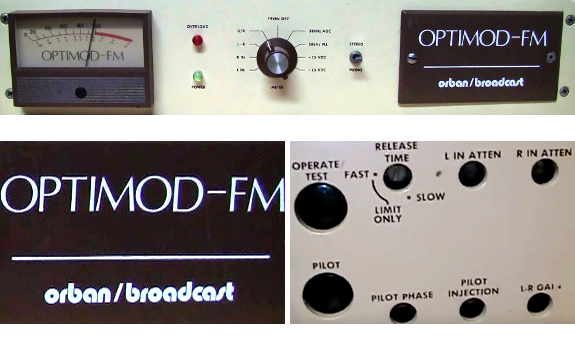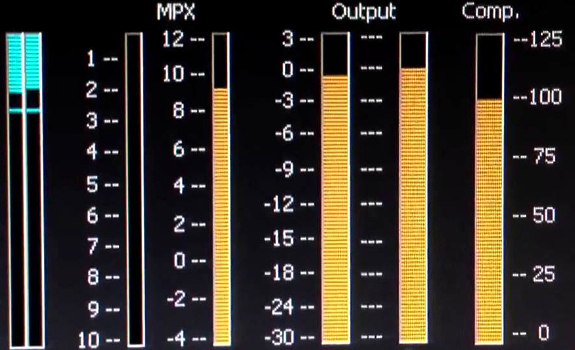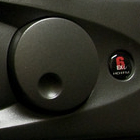A clean and bright sound, with low distortion and low fatigue, is what Bob Orban considers to be the best sound for a radio station.
When your product name is a synonym for your provided service, you’re usually the industry’s first comer or current leader. And even if Frank Foti has gained a significant market share with Omnia, many radio people still use ‘Optimod’ as a synonym for ‘processor’. In this interview, the founding father of on-air sound recalls how it all began… and how he’s developed some of radio’s most-used boxes, like the legendary 8100/XT2 combo.
“My heroes were disc jockeys of WABC”

Dan Ingram and his colleagues were role models during Bob Orban’s college radio years (image: Frank D’Elia)
Start in radio early
Coming from a musical background as a keyboard player, Orban developed a passion for radio during his college years from 1963 to ‘67. “They had a college radio with a commercial license, where I got bitten by the radio bug. It was a 17 kW station that covered central New Jersey. In the US, the FM band is divided above and below 92 MHz, with commercial licenses located above, and non-commercial ones below. We were at 103.3, in the middle of the commercial band, and sold spots to finance the operation. I mostly did engineering, but I also was on the air with a classical music show, and I was the music director for a year.” They had cart machines, and record players with slip mats to cue up vinyl records! Good old times…
 Listen to top stations
Listen to top stations
Living in New Jersey allowed him to aircheck major brands in New York City. “My heroes were disc jockeys of WABC, like Dan Ingram, whom everybody considered to be the best DJ ever.” He recalls that in those days, ‘ABC had a cume of 8 million listeners – incredible, compared to the audience reach of the city’s top stations now. That was due to a less competition, of course, but also thanks to a tight format and strong positioning:
[audio:http://www.radioiloveit.com/wp-content/uploads/bob-orban-optimod-audio-processing-interview-radioiloveit.com-01.mp3|titles=Bob Orban about 77 Music Radio WABC New York]
Be creative and innovative
The college station didn’t have any audio processing yet. “In the control room, we had a big flashing light, and we were expected to ride a gain on the console so the light wouldn’t flash. But that happened often, and the relay was so loud that it got picked up by the mic… So when I heard the relay clicking when somebody was on the air, I would call them and say: turn the thing down! Hahaha.” Later, they bought a Fairchild Conax, an early high-frequency pre-emphasis limiter for FM. The young student-engineer built his first compressor to combine it with, using “very simple” materials. “But everybody has to start somewhere.”
“A revolutionary idea at the time”

Orban’s Optimod 8000 was the first audio processor that included a stereo encoder (images: YouTube / vwestlife)
Gain broad radio experience
And look where you are now. There’s an Optimod in 1 out of 2 radio stations in the world?
“It’s hard to find statistics. We know we’ve sold tens of thousands of devices over the years, and the 8100 sold about 10.000 units on itself. We’ve been around for a long time; making Optimods since 1975.” After getting a master’s degree in electrical engineering from Stanford in 1968, he started Orban in the facilities of his father, developing mostly recording studio equipment at first. In this early twenties, he got his first patent for a stereo synthesiser, and worked as an engineer on music productions, including what is said to be the first commercial quadraphonic recording session. The album Gandharva was recorded in ‘71 in a cathedral. “Its reverb time was 6 seconds, so the musicians could adapt in real time to what was coming back from the walls and ceilings. It was an immersive and natural sound.”
 Limit audio processing peaks
Limit audio processing peaks
During his Stanford years, Orban was involved in a classical station that a college buddy had bought in California. “We noticed that even if we’d put peak limiters at the end of the audio processing, we saw a lot of peak overshoots; over-modulation.” Together with some friends, they figured out the need for non-overshooting low pass filters. “I put together a prototype of what was to become the Optimod 8000.”
See a market potential
Broadcast consultant Eric Small, who worked with stations in New York, envisioned a massive opportunity for the audio processor, and became involved in its marketing. “We decided that the only way that this was really going to work was putting the stereo encoder in the same package as the audio processor. That was a revolutionary idea at the time.” The concept leveraged new FCC rules by which the stereo encoder didn’t have to be a part of the transmitter anymore. As the Federal Communications Commission still regulated which equipment could be used as part of a station’s transmission chain, the engineer and his associate filed “a fairly big report” to prove that their processor was meeting all of the rules.
“A very exciting moment in my career”

Distortion cancellation for a cleaner sound was a feature of the Optimod 8100 (images: optimod.am, optimod.fm)
Reach new loudness levels
I can imagine that when you introduced the Optimod 8000, it was often used as part of a whole audio processing chain, combining it with separate, additional devices like exciters and maximisers to create a signature sound.
“Yes, the CBS Laboratories Audimax and Volumax were extremely popular at the time”, Bob Orban recalls. “RCA and Gates Radio also had a line of audio processing equipment, but CBS Labs had innovating things like a gated gain stabilisation on the Audimax compressor. Volumax was the first peak limiter that combined a moderate attack time gain control with a peak clipping at the end of the line, which was capable of quite a bit more loudness.” However, when combined with a transmitter’s stereo encoder, a Volumax (and similar devices) caused certain modulation problems. “The 8000 was the first processor that did not have that problem.” Eliminating these overshoots, stations could now sound up to 3 dB louder than before.
 Experiment with processing chains
Experiment with processing chains
That must have been quite a revolution?
“Yeah, it didn’t take very long before we had a wave of success for the product. It basically took over major-market processing. People also started to use other processors in front of it. I realised that I had to take it to the next level, so after doing the first AM processor; the Optimod 9000, I started to work on the second generation of FM.”
Filter out unwanted sounds
And that became the famous 8100!
“Yes. I came up with the idea of distortion cancel clipping for that one. It permitted much larger amounts of clipping, with acceptable amounts of distortion. A classic problem of super pre-emphasised clippers was that you would say an ’S’ and it would come out sounding like an ‘F’, because of all of the clipper distortion. The distortion cancellation takes away distortion below about 2 kHz. I had actually invented that for the Optimod AM 9000, where it was done with some analog delay lines. That was a very exciting moment in my career, because I finally got it working on instruments.” Orban remembers testing his device, playing music:
[audio:http://www.radioiloveit.com/wp-content/uploads/bob-orban-optimod-audio-processing-interview-radioiloveit.com-02.mp3|titles=Bob Orban about testing the Optimod 8100 and 9000]
“Digital signal processing has been very liberating to me”

Orban’s Optimod 8200 was the radio industry’s “first successful” digital audio processor (image: radiofreakz.de)
Clip without audible distortion
But he couldn’t use those same analog delay lines for the FM processor. “Their specifications were just not good enough; they had too much noise and too much distortion for FM. I figured out a way to do it by using the actual 15 kHz low-pass filters in the Optimod as part of the delay. That gets a little technical again, but it was a breakthrough that allowed a very high-quality implementation of distortion cancel clipping. Once again, from the programming point of view, you got another couple of dB out of it. So compared to where we were before, FM radio was suddenly about 5 dB louder, thanks to all of this. The Optimod 8100 was a huge hit for us; actually the biggest hit we’ve ever had. But people were still putting other compressors in front of it.”
 Become an equipment standard
Become an equipment standard
Yeah, like Z100, where it was part of a whole processing chain.
“Yes, so I decided that we needed to create something of our own. That became the XT, and later the XT2, which was a 6-band compressor that worked with the existing power and circuitry of the 8100, plugged into the back.” Bob Orban still considers that a good basic setup for a radio station, maybe even today.
Get fresh ideas & input
While he enjoys seeing his Optimod 8100 and XT2 creations still being a popular couple on eBay, he very much appreciates the new era that came after. “Digital signal processing has been very liberating to me as a designer. We came up with the first successful digital audio processor, Optimod 8200, and worked on it very much in secret. We brought in Greg Ogonowski – now our VP of Product Development – as a consultant. He contributed techniques he had developed for his Greg Labs 5-band processors, and we sort of combined the best of the 8100/XT2 stuff with his ideas into the 8200. When we introduced it at NAB in 1991, around the time that AKG had purchased us, it came as a total surprise to the industry.”
“Very punchy and very bright, with low distortion”

Bob Orban sees the Optimod 8600 & 8700 as further expansions of processing (image: YouTube / Adriano Ronchi)
Leverage new technical innovations
During the final development stages of the 8200, Frank Foti had become a serious competitor with his line of Omnia (formerly known as Cutting Edge) audio processors. “We realised that we had to take our processing up another step as well, so I engaged another round of design and invention. The 8400 was a result of that.” Orban introduced a new level of distortion cancel clipping, half-cosine interpolation composite limiter, and an active distortion controller. “Once again, we had stepped up our game, and had an extremely competitive processor.”
 Sound bright and clean
Sound bright and clean
How would you describe the differences between Orban and Omnia?
(sighs) “Well, uhm, you know, Frank makes a good box. He has a rock ’n roll attitude towards things. At least the Omnia 6 was not really scrupulous about avoiding distortion. Frank likes a very bright sound; not necessarily a perceived clean sound. I always prefer a cleaner sound, maybe at the expense of a little bit of ultimate punch and excitement.”
Avoid distortion and fatigue
Around 2008, Bob Orban felt that they needed to “step it up one more time”, so they started a 2-year R&D project resulting in their MX peak limiter technology. He describes it as “a very advanced distortion-adapted clipping that uses a psycho-acoustic model”, improving 3 things: “We got about 3 dB more brightness, so we were competitive with Omnia in that area, plus low distortion and low fatigue. Things we compromised in the Optimod 8400 and 8500, for the sake of low distortion and low fatigue, we didn’t compromise in the 8600 and 8700. We got an extremely clean-sounding processor that is very punchy and very bright, with low distortion. That’s where we’re at, at this point.”






Add Your Comment